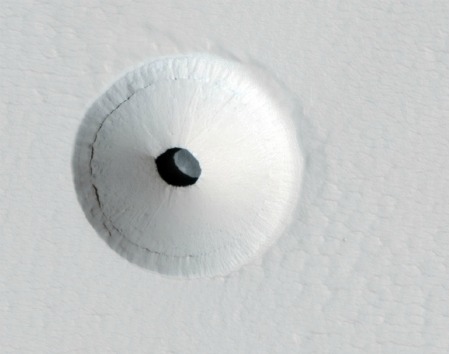Man that’s cool. It’s a sandpit on Mars that seems to lead to an underground cavern. Phil Plait has the scoop:
In the distant past, Mars was geologically active. Rivers of lava ran across the surface. If the surface of the lava hardens it can form a roof, allowing the lava underneath to continue flowing; these are called lava tubes and there are bazillions of them in Hawaii, for example. Eventually, the source of the lava chokes off and the lava flows away, leaving the empty tube underground. If the roof is thin in one spot it can collapse. Sometimes that just leaves a hole, but apparently in this case it was under a sand field. Some of the sand must have fallen into the chamber below and eventually blown away, leaving the pit and the hole. The pit is located not too far from Pavonis Mons, a known (long-dead) Martian volcano.
Mars was once thought to be dead as a doornail, geologically and biologically. The jury’s still out on the latter, but Mars does undergo a little more surface geology than some scientists initially thought. In addition to ancient lava tubes and occasional impacts, more modern superficial features rise and fall with the interaction of subsurface water, wind, and the planet’s wandering axis.
The earth is locked into a tight range of obliquity thanks to our largish moon, we’re currently tilted over at 23 1/2 degrees giving us seasons like the horrid summer we’re suffering through in Texas right now. Mars is pretty close to that mark, about 25 degrees, so it has earth-like seasons too. They just last almost twice as long because the Martian year is about 1.88 earth years. Mars even has a near 24 hour day!
But Mars lacks a large moon. Its obliquity could vary wildly over the course of several tens of millions of years, theoretically between zero and 180 degrees! That would mean Mars rolls on its side, one pole pointing to the sun for half its long year, the other in darkness. Water ice and maybe other substances build up where sunlight is scarce. Right now that means near the poles and inside craters in the shade provided by the rims. But all that changes if Mars keels over, the water sublimates away leaving spaces that collapse, it may even cause briny sandy muddy Mars-slides, and some of it relocates elsewhere causing frost heaving and other surface phenomena.
Come to think of it, an exposed lava tube would be a pretty good place for ice to congregate, and the walls would be easy to seal against the harsh Martian cold and lethally low pressures. Water, shelter, with sunlight and soil nearby … that sand pit and others like it could be the future home of real Martians, the kind who came by way of earth.


I’m sure there’s a sci-fi/horror movie about ancient tunnelling Martians somewhere in there.
Regardless of which, a cool picture accompanied by cool science. Presumably the variability of Mars’ axial tilt might be a contributing cause of the lack of (more complex) life on Mars. As if it wasn’t inhospitable enough anyway.